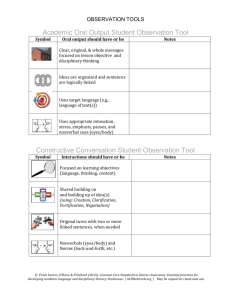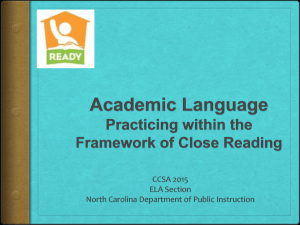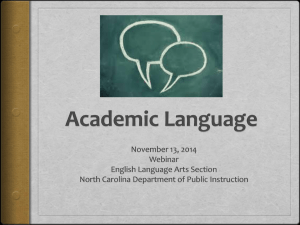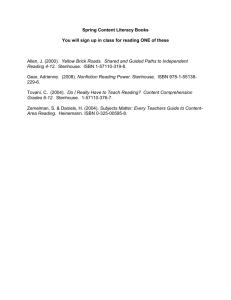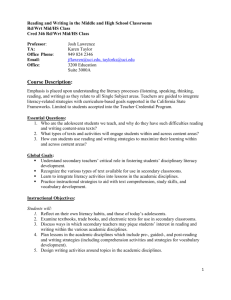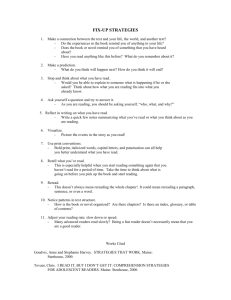Argumentation Activities - Academic Language Development Network
advertisement
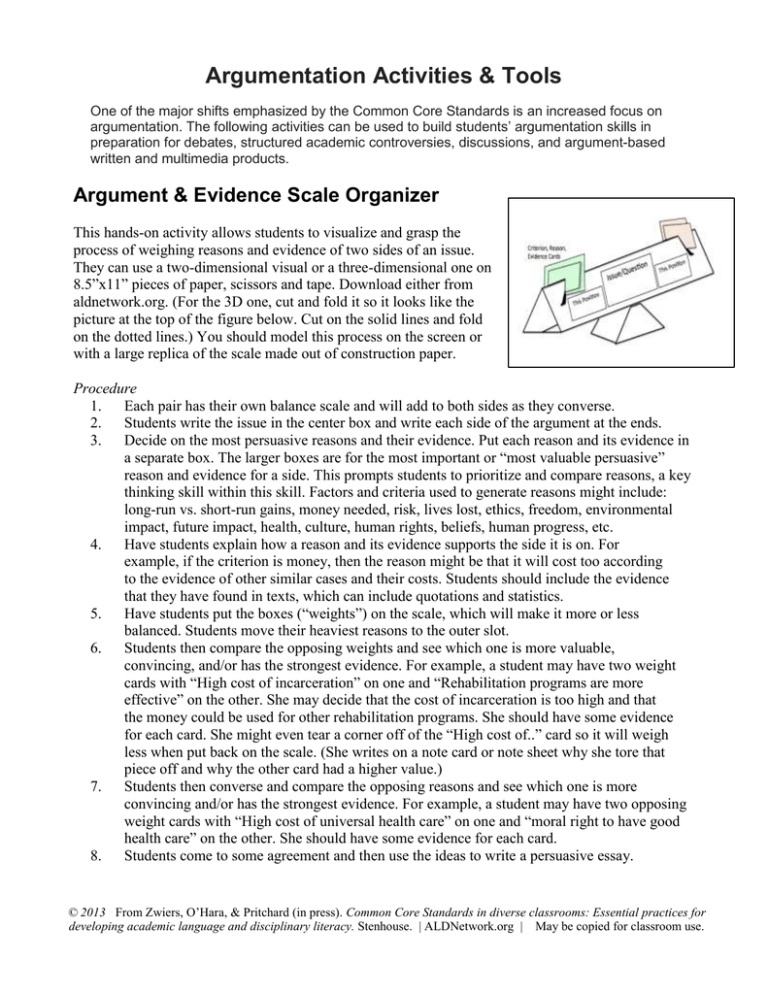
Argumentation Activities & Tools One of the major shifts emphasized by the Common Core Standards is an increased focus on argumentation. The following activities can be used to build students’ argumentation skills in preparation for debates, structured academic controversies, discussions, and argument-based written and multimedia products. Argument & Evidence Scale Organizer This hands-on activity allows students to visualize and grasp the process of weighing reasons and evidence of two sides of an issue. They can use a two-dimensional visual or a three-dimensional one on 8.5”x11” pieces of paper, scissors and tape. Download either from aldnetwork.org. (For the 3D one, cut and fold it so it looks like the picture at the top of the figure below. Cut on the solid lines and fold on the dotted lines.) You should model this process on the screen or with a large replica of the scale made out of construction paper. Procedure 1. Each pair has their own balance scale and will add to both sides as they converse. 2. Students write the issue in the center box and write each side of the argument at the ends. 3. Decide on the most persuasive reasons and their evidence. Put each reason and its evidence in a separate box. The larger boxes are for the most important or “most valuable persuasive” reason and evidence for a side. This prompts students to prioritize and compare reasons, a key thinking skill within this skill. Factors and criteria used to generate reasons might include: long-run vs. short-run gains, money needed, risk, lives lost, ethics, freedom, environmental impact, future impact, health, culture, human rights, beliefs, human progress, etc. 4. Have students explain how a reason and its evidence supports the side it is on. For example, if the criterion is money, then the reason might be that it will cost too according to the evidence of other similar cases and their costs. Students should include the evidence that they have found in texts, which can include quotations and statistics. 5. Have students put the boxes (“weights”) on the scale, which will make it more or less balanced. Students move their heaviest reasons to the outer slot. 6. Students then compare the opposing weights and see which one is more valuable, convincing, and/or has the strongest evidence. For example, a student may have two weight cards with “High cost of incarceration” on one and “Rehabilitation programs are more effective” on the other. She may decide that the cost of incarceration is too high and that the money could be used for other rehabilitation programs. She should have some evidence for each card. She might even tear a corner off of the “High cost of..” card so it will weigh less when put back on the scale. (She writes on a note card or note sheet why she tore that piece off and why the other card had a higher value.) 7. Students then converse and compare the opposing reasons and see which one is more convincing and/or has the strongest evidence. For example, a student may have two opposing weight cards with “High cost of universal health care” on one and “moral right to have good health care” on the other. She should have some evidence for each card. 8. Students come to some agreement and then use the ideas to write a persuasive essay. © 2013 From Zwiers, O’Hara, & Pritchard (in press). Common Core Standards in diverse classrooms: Essential practices for developing academic language and disciplinary literacy. Stenhouse. | ALDNetwork.org | May be copied for classroom use. 2-D Version 3-D version © 2013 From Zwiers, O’Hara, & Pritchard (in press). Common Core Standards in diverse classrooms: Essential practices for developing academic language and disciplinary literacy. Stenhouse. | ALDNetwork.org | May be copied for classroom use. Criteria Bar Graph for Evaluating Criteria Often, to decide what to do in life, we must use criteria to “weigh” supporting points against each other. Criteria are types of points used to make decisions, such as money, risk, environmental impact, human rights, etc. In this case, the decision to be made is whether or not to… . You can find the points in the texts or on your own, and here you must weigh them to evaluate how much they support a side of the argument. Procedure 1. In pairs, partners try to come to an agreement for the three points on each side that most support each side. 2. Students draw a bar below the point to show how strong it is as a point. As they work, they can use sentence starters such as o Yes, but does this point outweigh… o Perhaps, but they don’t cite evidence for… o The data suggests that… 3. Pairs prepare to explain to another pair which side is more supported and why they believe that the strongest point most supports that side. ….should… Should not © 2013 From Zwiers, O’Hara, & Pritchard (in press). Common Core Standards in diverse classrooms: Essential practices for developing academic language and disciplinary literacy. Stenhouse. | ALDNetwork.org | May be copied for classroom use. Conversation Cards In this pair activity, each student will be either A or B, playing different roles using different information that the other person needs or wants in order to solve a real-world-like problem. In this case, the two roles are a _______ and _______, who are deciding how to _______ on the issue. One of the key aspects of this activity is to use oral language (they shouldn’t look at the other’s card) to bridge the information gap. Students should challenge one another to provide evidence, when appropriate (adapted from Zwiers, 2008). A: - B: f - c Sentence Starters (choose two or three to put on the cards) That is an important point, but does it outweigh… But in the long run… Then again, Even though…., we believe that… If it requires…., then… Why is that important? Which is more important? Yet what about the influence of… Tell me more about why… How does that example support your argument? Procedure: 1. Teacher previews key vocabulary on the cards & goes over sentence starters. 2. Students read and try to memorize points and language on the cards. 3. They discuss and respond to points. They can look at the cards, if needed, but not read from them. 4. The debate the issue and come to a conclusion that they would recommend to the president. They can even take into account if it is an election year. © 2013 From Zwiers, O’Hara, & Pritchard (in press). Common Core Standards in diverse classrooms: Essential practices for developing academic language and disciplinary literacy. Stenhouse. | ALDNetwork.org | May be copied for classroom use. Fortify a Conversation In this activity, student pairs turn a basic conversation into a more formal, academic one. Procedure: 1. You start with half of an informal, non-academic transcript of a dialog about the topic of -----. 2. You then create the other half of the informal dialog in the rest of the ‘Basic’ column. 3. Then in the ‘Fortified’ column, fortify the conversation with more academic responses, as shown in the first two rows below. 4. Share your changes and justify them. Types of corrections and changes include: increasing the length each message; not overusing pronouns; using expressions such as in order to, however, in addition; softening all or nothing messages using some, could, might; and using evidence. 5. Have students orally rehearse the new dialog in pairs and monitor their progress. A B A B Basic I think they should stay. The government is shaky. Me, too. They gotta keep things calm. And they help the people who are homeless. But how long, I wonder? It seems like they are less needed now. Yeah. And it costs so much. Millions of dollars. We need it. Fortified In my opinion, the U.S. troops should remain in Iraq. They help to keep politics stable. I agree. The troops are needed in order to maintain the peace and to assist displaced people who no longer have homes. And yet I also wonder how much longer the troops should remain. The need seems to be diminishing. True. And we must consider the high cost of remaining. It is estimated that we spend 720 million dollars a day. Many people in this country could benefit from that money. A B A B A B © 2013 From Zwiers, O’Hara, & Pritchard (in press). Common Core Standards in diverse classrooms: Essential practices for developing academic language and disciplinary literacy. Stenhouse. | ALDNetwork.org | May be copied for classroom use. Survey Grid The survey grid is a matrix you can use to poll one another on issues. You get to hear similar ideas several times, reinforcing your thinking and vocabulary. Name Marlene Luis Ben Survey of Views on Mandatory Service Requirements Should ? Why? Should ? Why? Yes. Students What would you like to do? Yes. Total for Total against Total neutral Procedure 1. To fill in each row, talk to one person (no groups). Put his or her name in the left hand column, and ask the questions on the top. Jot down paraphrased answers in the corresponding boxes. 2. If you hear a key word or version of it (voluntary, impose), write it down and circle it. 3. When most spaces are filled in, read the notes and count up how many are for, against, or neutral in each of the first two columns; write the most popular service types on the third column. 4. Students then write up their conclusions complete sentences. They might start with: The results of my survey show that the majority of students are against/for…. Reasons include… 5. As a class, share out some of their findings. Opinion Continuum Procedure 1. After the teacher models what to do on a sample continuum, get into pairs. One partner (the opinion-giver) closes his or her book. The asker writes in his or her book. 2. The asker asks where the opinion-giver is on the continuum and why. The asker might ask clarifying questions (as a teacher might do). 3. The opinion-giver elaborates and justifies his or her opinion with evidence and/or examples. The opiniongiver student signs his or her name on the continuum at the appropriate point where it matches the level of his or her opinion. Students should not be directly in the middle. 4. After gathering four or more signatures, or when indicated by the teacher, the asker students must put their own name on their continuum and provide elaboration and justification to an opinion-giver. Regulate genetic testing Not regulate genetic testing © 2013 From Zwiers, O’Hara, & Pritchard (in press). Common Core Standards in diverse classrooms: Essential practices for developing academic language and disciplinary literacy. Stenhouse. | ALDNetwork.org | May be copied for classroom use. Interview grids Students create a simple chart like the one below (one or two questions) to record their classmates’ answers to a prompt or two. They paraphrase partner responses in the blank spaces. Emphasize to students that you will be looking for evidence of thinking skills, complex language (connected sentences and academic vocabulary), and content understanding. You only want brief notes on the spaces and no one should be reading their fine print. You can also tell students to just talk initially, and then give a short time to take notes. They should meet with just one other student and have good eye contact in each exchange. You can also follow a student around and see if his or her language gets longer and stronger throughout the activity. Name What causes earthquakes? Should we spend extra money to prevent earthquake damage? Me (pre) Me (post) Interview Grid sample © 2013 From Zwiers, O’Hara, & Pritchard (in press). Common Core Standards in diverse classrooms: Essential practices for developing academic language and disciplinary literacy. Stenhouse. | ALDNetwork.org | May be copied for classroom use.
